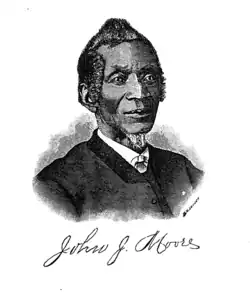John Jamison Moore

John Jamison Moore (1818 – December 9, 1893),[1] also known as J. J. Moore, was an American bishop of the AME Zion Church, journalist, church historian, and educator.[2][3][4] Moore's achievements include writing a history of the AME Zion Church, establishing the First AME Zion Church and the first Black school in San Francisco, and advocating for African-American access to education and religion through his newspaper, The Lunar Visitor.[5]
Early life
Moore was born enslaved in 1818, in what is today West Virginia.[6] At age 15, he and his mother escaped to Philadelphia to live in freedom.[7] Moore soon became involved in the African American Churches in that city. He eventually became a prominent preacher at the AME Zion Church in Philadelphia.[8]
Moore also traveled to New York City to participate in activities at the AME Zion Church there. He wrote about this church in his book, The History of The AME Zion Church in America. Founded in 1796 in the City of New York.[9][3]
Life in San Francisco
In 1852, Moore moved to San Francisco to further the church in that city. According to Bishop B.J. Walls, Moore was credited with,
"Planting the core tenets of freedom, as practiced by his denomination, on the Pacific Coast, in 1852".[10]
In August 1852, Moore founded the first AME Zion Church in San Francisco, initially located in a make shift space.[11]
In May 1854, under the leadership of Rev. Thomas Marcus Decatur Ward of St. Cyprian AME Church at Jackson and Virginia Streets in San Francisco, Moore founded the first private school for African-American children who could not attend local public school, called the San Francisco Colored School.[6][12][13][14] The school classes were held in the church basement, Moore served as the first teacher and principal. He created the school because African-American children were barred from the public schools in San Francisco. The first year, 23 students attended the school.[15] In 1872, the California Supreme Court ruled Ward v. Floor current segregation in educational practices as unconstitutional, breaching U.S. Constitution's Fourteenth and Fifteenth amendments.[16]
In 1862, Moore founded and became head editor of The Lunar Visitor newspaper.[6][17] According to the First AME Zion Church's website, the Lunar Visitor newspaper, "promoted civil rights and advocated developing institutions for educational, social and political skills useful in working toward a full participation in American Society,".[7] The newspaper was also "The only African-American magazine in the western part of the country," during the period it was being printed, according to Thomas Segady.[17]
In spring of 1868, Rev. Moore left California,[6][18] and was consecrated a Bishop in the denomination.
Later life
Moore later moved to Salisbury, North Carolina, where he married Francis Moore.[7] He died on December 9, 1893,[1] on the train home from a conference in Western North Carolina. He was buried in Salisbury.[7]
See also
References
- ^ a b "Obituary for J. J. Moore". The San Francisco Call and Post. 1893-12-10. p. 6. Retrieved 2025-07-11.
- ^ Coffman, Elesha (February 2001). "Marching to Zion". ChristianityToday.com. Retrieved 2018-12-12.
- ^ a b Moore, John Jamison (1884). The History of The AME Zion Church in America. Founded in 1796 in the City of New York. York, Pennsylvania: Teacher's Journal Office.
- ^ "John Jamison Moore". www.oxfordaasc.com. Journal of Slavery and Data Preservation. Retrieved 2025-07-10.
- ^ Murphy, Larry G.; Melton, J. Gordon; Ward, Gary L. (2013-11-20). Encyclopedia of African American Religions. Routledge. pp. 504–505. ISBN 9781135513382.
- ^ a b c d Adkins, Jan Batiste (2012). African Americans of San Francisco. Arcadia Publishing. p. 12. ISBN 978-0-7385-7619-0.
- ^ a b c d "About Our Founder." First A.M.E Zion Church, San Francisco. 2017. Accessed November 19, 2018. http://www.firstamezionsf.org/about-our-founder.
- ^ Morris, John (1977). "AME Zion Celebrates 125 Years". Sun Reporter (San Francisco, Calif.).
- ^ Roff, Sandra (1985). "Researching The History of Blacks in New York State". Afro-Americans in New York Life and History. 9: 43.
- ^ "Ministers, Laymen Meet: Zion Bishops Council Keys Call to Freedom". New Pittsburgh Courier. January 25, 1964.
- ^ "Cal. Senate recognizes 100th birthday of S.F. Zion church". Los Angeles Tribune. 1952-08-15. p. 12. Retrieved 2025-07-11 – via Newspapers.com.
- ^ Willard, Ruth Hendricks; Wilson, Carol Green; Baird, Joseph Armstrong (1985). Sacred Places of San Francisco. Presidio Press. p. 78. ISBN 978-0-89141-192-5.
- ^ "Ask A Librarian: Colored Schools". Napa County Historical Society. Retrieved 2025-07-11.
- ^ Taylor, Martha C. (2016-06-24). From Labor to Reward: Black Church Beginnings in San Francisco, Oakland, Berkeley, and Richmond, 1849-1972. Wipf and Stock Publishers. pp. 5–6, 11–12. ISBN 978-1-4982-3281-4.
- ^ Montesano, Philip M. (July 1, 1973). "San Francisco Black Churches in the Early 1860's: Political Pressure Group". California Historical Quarterly. 52 (2): 145–152. doi:10.2307/25157430. ISSN 0097-6059. JSTOR 25157430.
- ^ Campbell, Marne L. (2012-01-01). "African American Women, Wealth Accumulation, and Social Welfare Activism in 19Th-Century Los Angeles". The Journal of African American History. 97 (4): 376–400. doi:10.5323/jafriamerhist.97.4.0376. JSTOR 10.5323/jafriamerhist.97.4.0376. S2CID 149013832.
- ^ a b Segady, Thomas, Berardi, Gayle (1991). "Community Identification and Cultural Formation: The Role of African-American Newspapers in the American West". The Griot. 10: 13–19.
{{cite journal}}: CS1 maint: multiple names: authors list (link) - ^ Carter, Jennie; Gardner, Eric (2007). Jennie Carter: A Black Journalist of the Early West. University Press of Mississippi. p. 25. ISBN 978-1-60473-313-6.